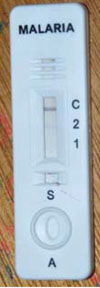Typhoid fever
In the final section of this study session, we turn to typhoid fever – a bacterial faeco-oral disease caused by Salmonella typhi bacteria, which is classified as a febrile illness (not a diarrhoeal disease). The incubation period is usually one to two weeks. Although typhoid fever can cause diarrhoea in children, it is rare in children of less than five years of age. In adults, diarrhoea may be present in the early stage of the illness, but this quickly turns to constipation. The main distinguishing feature is a very high fever (39oC to 40oC), with headache, lethargy, loss of appetite, and sometimes rose-coloured spots on the chest. If you are trained to palpate the abdomen, you may be able to feel an enlarged liver and spleen.
Typhoid fever is a major health problem in poor communities and is endemic (always present at a relatively constant rate) in Ethiopia. The WHO estimates that there are about 17 million cases worldwide every year. Transmission of typhoid fever can occur by the direct faeco-oral route, but it is mainly transmitted indirectly through contaminated water and food.
What other febrile diseases have you learned about so far in this Module, i.e. with high fever as one of their main manifestations?
Malaria and meningococcal meningitis are febrile diseases. (In Study Session 36, you will learn about two more: louse-borne relapsing fever and typhus.)
You can suspect a case of typhoid fever based on your clinical diagnosis, but because the symptoms of typhoid fever are similar to that of malaria, you should first use the malaria rapid diagnostic test (RDT) if you are in an area where malaria is endemic (Figure 33.10). Even after ruling out malaria, you can't be sure of the diagnosis of typhoid fever, because meningitis and relapsing fever can also present with similar symptoms and signs. Therefore, if you suspect typhoid fever, refer the patient to the nearest higher level health facility for laboratory diagnosis and specialist treatment.

As with other faeco-oral diseases, your role in the prevention and control of typhoid fever is giving health education to your community on measures that aim to interrupt faeco-oral transmission. In the next study session, we will focus on faeco-oral diseases caused by single-celled parasites and helminths (worms).